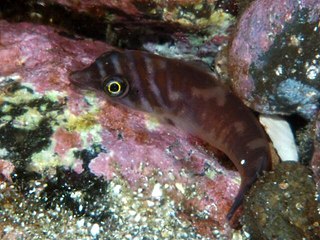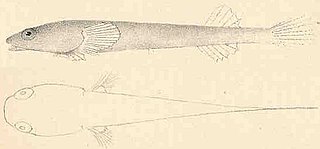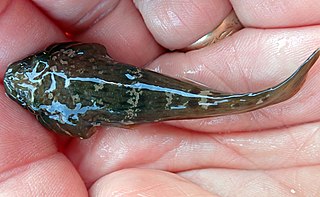The New Zealand urchin clingfish is a clingfish. It is found around New Zealand wherever sea urchins are present. Its length is between 2 and 3 cm.

Clingfishes are fishes of the family Gobiesocidae, the only family in the order Gobiesociformes. These fairly small to very small fishes are widespread in tropical and temperate regions, mostly near the coast, but a few species in deeper seas or fresh water. Most species shelter in shallow reefs or seagrass beds, clinging to rocks, algae and seagrass leaves with their sucking disc, a structure on their chest.
Dellichthys is a small genus of clingfishes from the family Gobiesocidae which are endemic to New Zealand. It had been regarded as a monotypic genus but a second species was described in 2018.
Hector's clingfish, Gastroscyphus hectoris, is a clingfish of the family Gobiesocidae, the only species in the genus Gastrocyathus. It is found all down the east coast of New Zealand around the low water mark amongst seaweed, on rocky coastlines. Its length is up to 6.4 centimetres (2.5 in) SL. This species was described in 1876 by Albert Günther as Crepidogaster hectoris from a holotype collected on the south shore of the Cook Strait. Günther honoured the Scottish-born scientist James Hector (1834-1907) who was the Director of the Geological Survey of New Zealand and who presented type to the British Museum.
The giant clingfish, Haplocylix littoreus, is a clingfish of the family Gobiesocidae, the only species in the genus Haplocylix. It is found all down the east coast of New Zealand around the low water mark amongst seaweed, on rocky coastlines. Its length is up to 15 centimetres (5.9 in). This species was originally described as Cyclopterus littoreus in 1801 by Johann Reinhold Forster, John C. Briggs subsequently placed it in the monotypic genus Haplocylix. Its closest relative appears to be the Caribbean deepwater clingfish Gymnoscyphus ascitus.

Apletodon is a genus of marine fish in the family Gobiesocidae (clingfishes). The genus was first named by John Carmon Briggs in 1955.

Arcos is a genus of clingfishes.

Cochleoceps is a genus of clingfishes endemic to the waters around Australia.

Diplecogaster is a genus of fish in the family Gobiesocidae found in Black Sea, Mediterranean Sea and Atlantic Ocean.

The blunt-snouted clingfish is a species of clingfish found along the Mediterranean Sea coasts from Syria to Spain. This species grows to a length of 5 centimetres (2.0 in) TL. The blunt-nosed clingfish is a little known species of shallow water along the littoral of the northern Mediterranean from Alicante to northern Israel. It can survive out of the water and occurs only among intertidal pebbles and sand.

Kopua is a genus of clingfishes found in the Pacific Ocean.
The little clingfish is a species of clingfish found in reef environments along the coast of Australia. This species grows to a length of 3 centimetres (1.2 in) TL. This species is the only known member of its genus. This species was described by Edgar Ravenswood Waite as Diplocrepis parvipinnis in 1906 with a type locality of Long Bay, Sydney, New South Wales. In 1931 Gilbert Percy Whitley raised the monotypic genus Parvicrepis for this species.
Pherallodiscus is a genus of clingfishes native to the central eastern Pacific Ocean along the coast of Mexico. Based on genetic studies the genus should be merged into Gobiesox.

The Posidonia clingfish is a species of clingfish native to the Australia coast. This species grows to a length of 2 centimetres (0.79 in) SL. Pale green to pale blue with fine spots forming dark reticulations on back and sides, larger blue spots often on back, and a pinkish to brown line from snout to gill cover. The posidonia clingfish is endemic to southern Australia where its range extends from Corner Inlet in Victoria west as far as Rottnest Island in Western Australia. It occurs down to a depth of 10 metres (33 ft) where it is found on macroalgae and within seagrass beds, its favoured substrate to adhere to is the leaves of the sea grass Posidonia australis. This species is the only known member of its genus and was described by John C. Briggs in 1993 with a type locality of Fiddler's Bay which is 16 kilometres south of Tamby Bay in South Australia. Briggs gave the species the specific name hutchinsi in honour of the ichthyologist Barry Hutchins of the Western Australia Museum in Perth, Western Australia.

Rimicola is a genus of clingfishes found along the coasts of the eastern Pacific Ocean.

Trachelochismus is a genus of clingfishes endemic to the shores of New Zealand, with currently three recognized species in this genus:
Unguitrema nigrum, also known as the Black crinoid clingfish is a species of clingfish endemic to Papua New Guinea. This species occurs Madang Lagoon in Madang District, Madang Province, Papua New Guinea. This species is the only known member of its genus. It was collected from a crinoid, Oxycomanthus bennetti, of the black phase.

Diplecogaster bimaculata, the two-spotted clingfish, is a species of fish in the family Gobiesocidae found in Black Sea, Mediterranean Sea and Atlantic Ocean where it is found on rocks and among seagrass or shell beds.
Gobiesox cephalus, the riverine clingfish or smooth clingfish, is a species of clingfish from the family Gobiesocidae. It is found in the coastal river drainages of the Caribbean from Cuba south to Colombia and Venezuela. It occurs in freshwater, and sometimes in brackish water, preferring a fast current. It is a solitary species which feeds on fishscales, insects and small fish. It is the type species if the genus Gobiesox and was described by Bernard Germain de Lacépède in 1800 with Amérique méridionale given as the type locality.
Opeatogenys gracilis is a species of clingfish from the family Gobiesocidae which is found in the Mediterraean Sea and in the eastern Atlantic Ocean. Suggested common name for this species are the pygmy clingfish and the seagrass clingfish.








